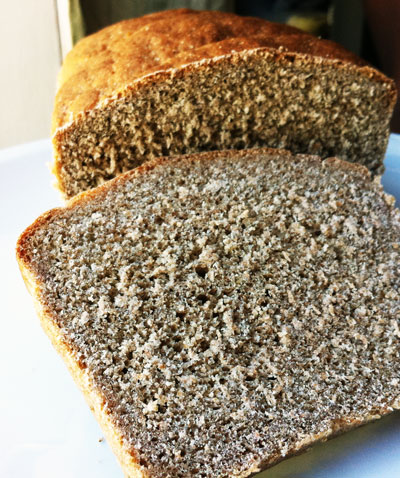Everybody knows that fresh bread is delicious, but what about the flour it’s made from? I recently came into a bag of freshly milled flour, and I can now tell you it makes a big difference.
A little background: In addition to roasting some of Birmingham’s best coffee, Woody Wiginton of FinerGrind Coffee Roasters also grinds his own flour. (He also lives on a farm in Warrior and has traveled all over the world. The man is kind of my hero.)
At the last FoodBlogSouth meetup, Woody gave me small bags of rye and whole wheat flour he had milled a few days before. The rye was grain he grew himself—talk about local—and the wheat he ordered from Canada (it’s way too hot to effectively grow wheat in Alabama).
So why is freshly milled flour better? Once you break open the grains, oxygen begins to damage the fats in any kind of flour (especially whole-grain flours), altering their flavor. The more time between milling and baking, the more flavor is lost. The bread I made from Woody’s flours was much sweeter and nuttier than my usual whole-wheat.
Sadly, Woody isn’t making flour in quantities large enough to sell (yet), so I’ll have to rely on his generosity to get some more (hint, hint) to taste this bread again.
But I figured this was a good opportunity to share my all-purpose bread recipe. Judging by the number of books written on the subject, you’d think home bread baking was unbelievably fussy and difficult. It’s really not. The formula below can use any kind of flour you can throw at it and any mix-ins you can put in it to make any kind of bread you want. (Don’t use all the optional ingredients in one loaf!) The texture of the final product is based on a combination of your exact ratio of flour to water and how long you let it rise; experiment with both to figure out what you like best.
All-Purpose Bread
makes 1 loaf
The basics:
1 tbsp. instant dry yeast
1 1/2 cups warm water
9 oz bread flour, plus extra if needed
9 oz other flour (use more bread flour for white bread, whole-wheat for wheat, rye for rye, etc.)
1 tsp. salt
Optional extras:
1 tbsp. vegetable oil (makes softer bread)
2 to 3 tsp. honey
1 to 2 tbsp. dried herbs
1/4 to 1/2 cup dried fruit or seeds (carraway, flax, sunflower, etc.)
1/4 to 1/2 cup chopped olives
1/4 to 1/2 cup shredded cheese (Parmesan works especially well)
1/4 to 1/2 cup chopped or melted chocolate (milk, white, or dark all work)
Combine the yeast and water in the bowl of a stand mixer fitted with the dough hook. Let stand for a minute or two, then add the flours, salt, and any optional extra ingredients. Mix on low speed until the dough comes together, then increase the speed to medium and knead until smooth and elastic, about 10 minutes. If the dough sticks to the side of the bowl, add extra bread flour (reduce the speed on the mixer until it is incorporated).
Remove the bowl from the mixer, form the dough into a ball, place back in the bowl and cover with a damp kitchen towel. Let rise until doubled, about 1 hour. Punch down the dough, knead briefly, and place into a lightly greased loaf pan or shape into whatever shape you like and place on a baking sheet lined with a Silpat or parchment paper.
Let rise for 20 to 30 minutes, then turn the oven on to 425°. Let the oven preheat for about 15 minutes (the dough will have pretty much doubled at this point). Cut 3 or 4 slashes in the top of the loaf and bake until the bread is golden brown and sounds hollow when tapped, 45 minutes to 1 hour. Place on a cooling rack until completely cool (if using a loaf pan, remove the loaf from the pan immediately after removing from the oven).
